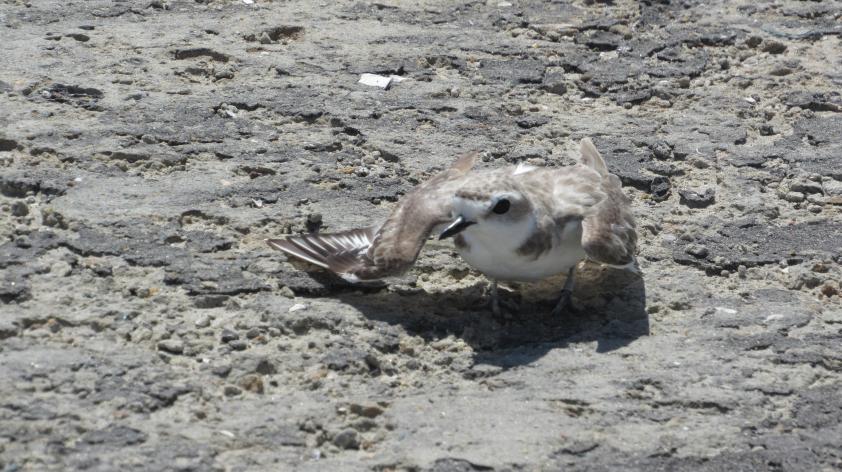
Crazy Martha: a Story of Plover Persistence
Multiple times every week, biologists from the San Diego Zoo Institute for Conservation Research don yellow vests, affix a blinking light onto their truck, and contact Naval Base Coronado's North Island Tower. They're hoping to get permission to venture out onto an active airfield.
What business do biologists have on an active naval airfield? They are searching for nesting western snowy plovers. The plovers are a threatened species of shorebird that, despite intense gusts of wind from regular air traffic, have decided to make the desolate expanse between runways their home.
Once relatively abundant across the coasts of Washington, Oregon, and California, the western snowy plovers have experienced a population decline. It is estimated there are now less than 2,000 breeding plovers nesting along the California coast.
One contributing factor to this trend is the loss of the plover’s historic habitat. Preferring to nest within open, undisturbed beach and estuary habitat, with abundant seaweed and vegetation for foraging on invertebrate prey, the birds have been having a harder time finding safe places to settle down as more and more beaches become heavily disturbed or maintained by humans. Grooming of beaches removes the wrack, where invertebrate prey thrive among drying patches of kelp brought by the tide. Dogs, vehicles, and beach users can trample and destroy dunes, vegetation, and nests. Predators cue in on food residues left over after holiday picnics or in bins that are left uncovered.
It is not surprising then that as their environment has changed, the plovers have started to adapt. After all, predators and beach recreationists are rare on airfields!
There are many concerns associated with some of these daring birds building their nests on airfields. The Department of Defense has created a Bird/Wildlife Aircraft Strike Hazard (BASH) prevention program for situations like these. From the aircraft’s perspective, it is very dangerous to encounter a bird during takeoff or landing. It is a great risk to the safety of any personnel or cargo on an aircraft if it becomes damaged from coming in contact with wildlife.
In addition, biologists have concerns about the birds' safety, especially for federally-protected species which are already at risk from population declines. It is a long, dangerous path for chicks to follow to the bodies of water where they will forage. The nests are almost entirely without shelter, which leaves eggs open to predation.
It is scary for a person to cross a runway--let alone a tiny plover chick!
For the safety of both the people and the birds, biologists will carefully monitor and eventually collect the nests found on the airfield. So far this season, six nests have been found between the runways. The monitors suspect that one female plover is responsible for many of these nests nearby, and has re-nested on the airfield multiple times!
The biologists have affectionately nicknamed her “Crazy Martha”. She is color-banded, but she is also easily identified by her wild and passionate “broken wing displays”, a technique plovers use to distract predators by acting as if they are injured in order to lure predators away from their well-camouflaged nests. Whether you find her crazy or courageous, Crazy Martha is a tenacious parent!
To keep the airfield safe for both the military and the birds, biologists collect the eggs from airfield nests and take them to a SeaWorld care facility as part of a formal agreement with the Navy, the US Fish and Wildlife Service, and SeaWorld San Diego. There they will be hatched, and when the fledglings are ready, they will be released back onto the beach.
Making the best of a difficult conflict between people and wildlife, this method has helped to keep the men and women serving our country safe. It has also allowed Crazy Martha’s chicks a chance at a productive life, far away from the airfield (or so we hope, until she nests again!).
VIDEO: Female western snowy plover performing broken wing display. A mini-enclosure (ME) can be seen in the background. MEs are set up by biologists to keep plover nests safe from predation during incubation. The other wire box next to the ME is a box trap used to band adult birds (Video by: G. Ibarguchi, K. Murbock, and M. L. Post, 2016, courtesy of Naval Base Coronado).
VIDEO: Female western snowy plover calling, running, and performing the broken wing display (Video by: R. Smith, 2017, courtesy of Marine Corps Base Camp Pendleton).
Alyssa Davidge worked as part of the San Diego Zoo Terns and Plovers field crew during the 2016 breeding season, mainly at Naval Base Coronado. She continues her career as a wildlife biologist working in the field with California Condors and in wildlife rehabilitation.













